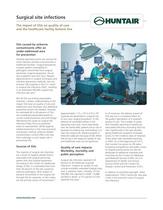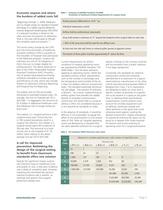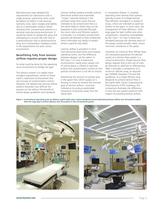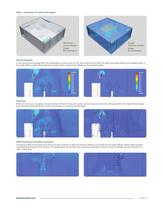
Catalog excerpts

Surgical site infections The impact of SSIs on quality of care and the healthcare facility bottom line SSIs caused by airborne under-addressed area Hospital operating rooms are among the most infection-sensitive environments in healthcare facilities. Surgical procedures ncrease patient vulnerability to pathogens transmitted from surgical personnel, surgical equipment, the air and a patient's own skin flora. Despite advancements in surgical techniques and of every 100 surgeries in the U.S. result in surgical site infections (SSIs)1, resulting in an estimated 290,485 surgical site Not all SSIs are entirely preventable However, a better understanding of the impact SSIs have on quality of care and healthcare costs illustrates why additiona preventive actions are needed. Likewise, an estimated 40 to 60 percent of SSIs are considered preventable based on current medical practice and technology.3 Identifying the causes of surgical site nfections helps focus on potentia areas of improvement. While hygiene- related prevention is the most practiced and proven method, airborne-related contamination control offers one area that could play a much larger role in preventing SSIs. The majority of surgical site infections are a result of hygiene-related factors associated with surgical personnel, patient skin and surgical equipment. According to the Center for Healthcare Design (CHD), it is estimated that more than 30 percent of SSIs are caused by airborne pathogens. With respect to bacteria transmitted to the surgical site through the air, squames, or skin scales, squames are generated in a typical two to four hour surgical procedure.6 In the absence of controlled airflow in the operating room and, more importantly, over the sterile field, patients are at risk of squames circulating over and landing in or near the surgical site. Bacteria present in these skin scales are one cause of SSIs. When SSIs do occur, the impact on quality of care and healthcare costs can be significant. Quality of care impacts: public perception Surgical site infections represent 20 percent of all healthcare acquired nfections1. Impacts on quality of care nclude morbidity, extended hospital stays and, in extreme cases, mortality. Of the resulted in death, or 4.5 percent of SSIs In all instances, the adverse impact of SSIs also has a cumulative effect on the public's perception of a hospital's quality of care. The number of states that mandate reporting of healthcare associated infections (including SSIs) has risen significantly in the past decade, giving healthcare recipients increased access to HAI incidence data at hospitals Three states had mandated reporting that number has grown to 28 states.7 ncreasing transparency and public access to hospital performance can also be attributed to additional initiatives and ncentives by the Centers for Medicare Department of Health and Human Disease Control and Prevention (CDC) In addition to providing oversight, these organizations, CMS in particular, also play a role in the economic costs of surgical site infections.
Open the catalog to page 1
Economie impacts and where the burdens of added costs fall Table 1. Summary of ASHRAE Standard 170-2008: Ventilation of Healthcare Facilities Requirements for Surgical Suites "Beginning October 1, 2008, Medicare can no longer assign an inpatient hospital discharge to a higher paying Medicare- severity diagnosis-related group (MS-DRG) if a selected condition is listed on the claim and was not present on admission. That is, the case will be paid as though the condition were not present. "2 This recent policy change by the CMS puts the financial burden of healthcare acquired conditions (HACs)...
Open the catalog to page 2
Manufacturers have adopted ISO requirements for cleanrooms with a single purpose: preventing what could be billions of dollars in lost revenue, warranty costs, back charges and liability due to a catastrophic product failure resulting from contaminants present in a sensitive manufacturing environment. It would be foolish to equate the value and well-being of a human life with that of a semiconductor chip or pharmaceutical drug, but a tremendous imbalance exists in the requirements for each critical Benefitting fully from laminar airflow requires proper design So what could be done for the...
Open the catalog to page 3
Table 3. Comparison of Laminar Flow Designs Minimum Array Design Single Diffuser Design 35 fpm 62º entering air 35 fpm 62º entering air Thermal Properties: In the minimum array design (left), the temperature varies as much as 10°F due to the thermal effects of lights and people (lighter blue shaded areas). In the single diffuser (right), the temperature remains fairly constant from diffuser to the operating table. Turbulence: While the minimum array design contains laminar diffusers, it does not create a laminar ow environment in the space (left). The single diffuser design does achieve the...
Open the catalog to page 4
Given the quality of care, economic and public relations consequences of SSIs, consideration should be given the operating room to include some measure of contamination control and aerobiological quality standards. The technology and design practices have already been successfully implemented other critical-process manufacturers facing similar consequences in a different context. International standards currently exist that identify the size and quantity of particulates allowed in a given space over a given amount of time. Granted, many obstacles exist within the operating environment that...
Open the catalog to page 5
CLEANSUITE® Systems: Bringing cleanroom technology all-inclusive, modular ceiling diffuser system that is hung directly above the operating table in surgical suites and other applications requiring low turbulence, microbial-free airflow. CLEANSUITE systems help prevent SSIs and other healthcare-acquired infections (HAIs) caused by airborne contaminants in hospital operating rooms, outpatient surgery centers and other sensitive healthcare applications. CLEANSUITE systems have evolved from the manufacturing environments and other sensitive products, where contamination is strictly controlled...
Open the catalog to page 6All Huntair catalogs and technical brochures
-
Air Handling Units
12 Pages
-
CSU Air Handlers
4 Pages
-
Standard CRAC
8 Pages
-
HD Rack Cooling
4 Pages
-
CLEANSUITE Sales Brochure
4 Pages
-
Heat Reclaim Units
4 Pages
-
Mini Cabinet Units
4 Pages
-
HUNTAIR CSU SB 0105
4 Pages










